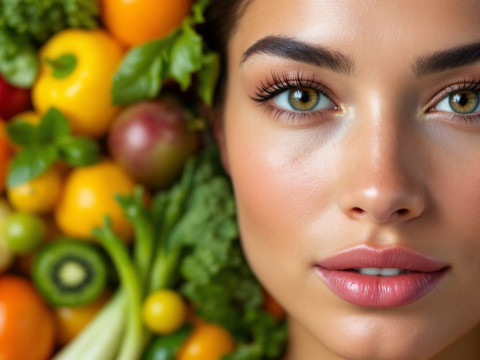So, you’re staring at the mirror, and gee, that skin of yours—maybe it isn’t quite the glow you were hoping for. You’ve tried the creams, the serums, the face masks that promise to reveal the glowing deity within, but sometimes, skincare needs to come from the inside out. Trust me on this; I’ve been exactly where you are. It’s time to explore the wonderful world of foods to clear skin—not just to promise beauty but to promote overall health.
Your Skin, Your Canvas
Skin—a reflection of inner health. It speaks volumes about what’s going on inside, often mirroring stress, lifestyle choices, and yes, diet. And don’t we all sometimes realize, perhaps a little too late, how we’ve neglected the basics? But don’t worry. Let’s flip that script right around, with tools we use every day, right from our kitchens.
Let’s Talk About Greens
First things first, greens. Greens are not just for those smoothies touted by wellness gurus on Instagram. There’s a reason kale’s got a cult following. Cruciferous veggies like broccoli and Brussels sprouts are packed with vitamins A and C. These antioxidants (I’ve got detention vibes with that word) are warriors against skin-aging free radicals. So, next time you’re grocery shopping, toss some extra spinach into your cart and imagine it as your soon-to-be botanical defense layer.
How Exactly Do Greens Affect the Skin?
Oh, I’m glad you asked. Vitamin C in greens boosts collagen production, which keeps your skin looking youthful and firm. Vitamin A? It’s an ace for fighting inflammation, a common culprit behind acne flare-ups. See where I’m going with this?
- Spinach: Rich in folate, iron, vitamins A and C.
- Brussels Sprouts: High in antioxidants and detoxifying compounds.
Spice It Up—Literally
ginger and turmeric. Turning boring meals into exciting ones isn’t just about spice; it’s about lavishing your skin with the anti-inflammatory goodness they bring.

- Turmeric: Contains curcumin, which fights inflammation.
- Ginger: Improves circulation and reduces inflammation.
Just sprinkle some turmeric into your next curry, or toss a slice of ginger into your morning smoothie.
Berry Your Worries
You’ve heard this before: berries are superfoods. But honestly, these are friends your skin wants to hang out with. Blueberries, strawberries, raspberries—they’re loaded with antioxidants that shield skin from damage and give it that healthy glow.
Berry Benefits Checklist
- High in Vitamin C: Essential for collagen synthesis.
- Packed with Antioxidants: They protect your skin from the environmental damage.
Fat’s Not the Foe
Wait, processed fats? Those you can kick out. But good fats, hey—they’re your skin’s best defender. Omega-3 fatty acids from sources like salmon, flaxseeds, and walnuts? Those are the allies you’re looking for.
Foods Rich in Omega-3s
- Salmon: Helps with moisturizing the skin from inside out.
- Walnuts: A convenient snack providing essential fatty acids.
- Flaxseeds: Versatile enough to sprinkle in almost anything.
Omega-3s reduce inflammation and keep the skin supple and moisturized. You see where this leads, don’t you? Say goodbye to dullness and dryness.
Sip Away Your Skin Woes

Hydration—an oldie but a goodie when it comes to radiant skin. Water just might be plain old magic. But let’s spice it up: green tea, which has catechins, shows to improve skin elasticity. You see how nature unfailingly plies us with stuff our bodies actually need?
Thirst Quenchers for Glowing Skin
- Green Tea: Loaded with antioxidants, offering anti-inflammatory benefits.
- Water: Fundamental but effective—keeps skin hydrated and fortified.
Remember the Sweet Potato
Not what you were expecting, huh? The sweet of potatoes is a surprising hero, offering beta-carotene, which not just converts to vitamin A, but can actually act as a natural sunblock. How’s that for a two-in-one?
Benefits Breakdown
- Beta-Carotene Boost: Protects skin from sun damage.
- Fiber Content: Promotes healthy digestion, which in turn, fosters good skin health.
Enough With the Processed Stuff
A beat on this drum a bit. Processed foods, with their sneaky sugars and oils, might not be out for your skin’s best interest. Here’s the scoop: high sugar levels can lead to glycation, damaging your skin’s proteins, like collagen. It’s the stuff that makes pimples act smug and wrinkles sassier.
Think Twice About
- Sugary Snacks: Promote yucky and untimely breakouts.
- Salt-Laden Foods: Dehydrate and hurt your skin’s texture.
Your Kitchen’s Tiny Miracle Worker: Nuts and Seeds

Some of us sprinkle them, some steal handfuls straight from the jar—either way, nuts and seeds (like almonds and sunflower seeds) are rich in Vitamin E, protecting skin from oxidative stress and giving it a radiant touch.
- Almonds: High in vitamin E, moisturizing from within.
- Sunflower Seeds: Bursting with nutrients that nourish the skin.
Circling Back: The Nice-to-Haves
Let’s circle back to some new old friends: avocados. Rich in healthy fats, these creamy delights provide skin with the necessary vitamin E, and let’s admit it—they make toast feel like a treat from the fancy café downtown.
Highlights of Avocados
- Helps hydrate: Naturally moisturizes and softens the skin.
- Rich in antioxidants: Combats the free radicals threatening your glow.
Hair-Toss Moments with Bright Veggies
Yeah, carrots and bell peppers shout color and vibrancy—exactly the mood you want your skin to emulate. High in beta-carotene, these veggies double down as nature’s sun filters. They’re also perfect grab-and-go snacks. Picture munching them during an Instagram break; how healthy-chic does that look?
Recap: To Warmer Glows Ahead
Befriending the right nutrients can boost skin’s resilience and glow. Say goodbye to quick fixes that come in bottles, and trust your intuition and your fork to lead the way. Consistency in diet, paired with those creams and rituals that already spark joy, can create synergistic results worth the added effort.
Realizing the power of foods to clear skin makes you look inwards rather than outwards. Now, who’s ready for that mirror-worthy glow that screams healthy and happy from a mile away? If you’re nodding, the kitchen just became your best (and prettiest) friend.
Grab your grocery totes, and let’s make clear skin more about balance and far less about perfection. After all, just take a page from an imperfect conversation, they often hold the most beautiful truths.
Frequently Asked Questions
What are the benefits of using a hair mask in my hair care routine?
Using a hair mask can provide several benefits, including hydration, smoothing, strengthening, curl definition, heat protection, and damage repair. Hair masks infuse the hair with moisture, help coat the hair shaft to seal split ends, reduce breakage, and protect the hair from heat styling and environmental damage[1][4].
What ingredients should I look for in a hair mask?
Effective hair masks often include ingredients such as coconut oil, argan oil, shea butter, honey, avocado oil, green tea, and coconut water. These ingredients provide nourishment, moisturize, and protect the hair, offering benefits like softening, moisturizing, and protecting against damage[2][5].
How often should I use a hair mask in my routine?
You should use a hair mask whenever your hair feels dry, unmanageable, or in need of intense hydration. This can vary depending on your hair type and needs, but generally, using a hair mask once or twice a week can help maintain healthy and moisturized hair[1][4].
How do I apply a hair mask for the best results?
To apply a hair mask effectively, shampoo your hair first, then apply the mask, focusing especially on the ends where hair tends to be the most damaged. Leave the mask on for anywhere from 10 minutes to overnight, depending on the type of mask and your hair’s needs[1][4].
References










